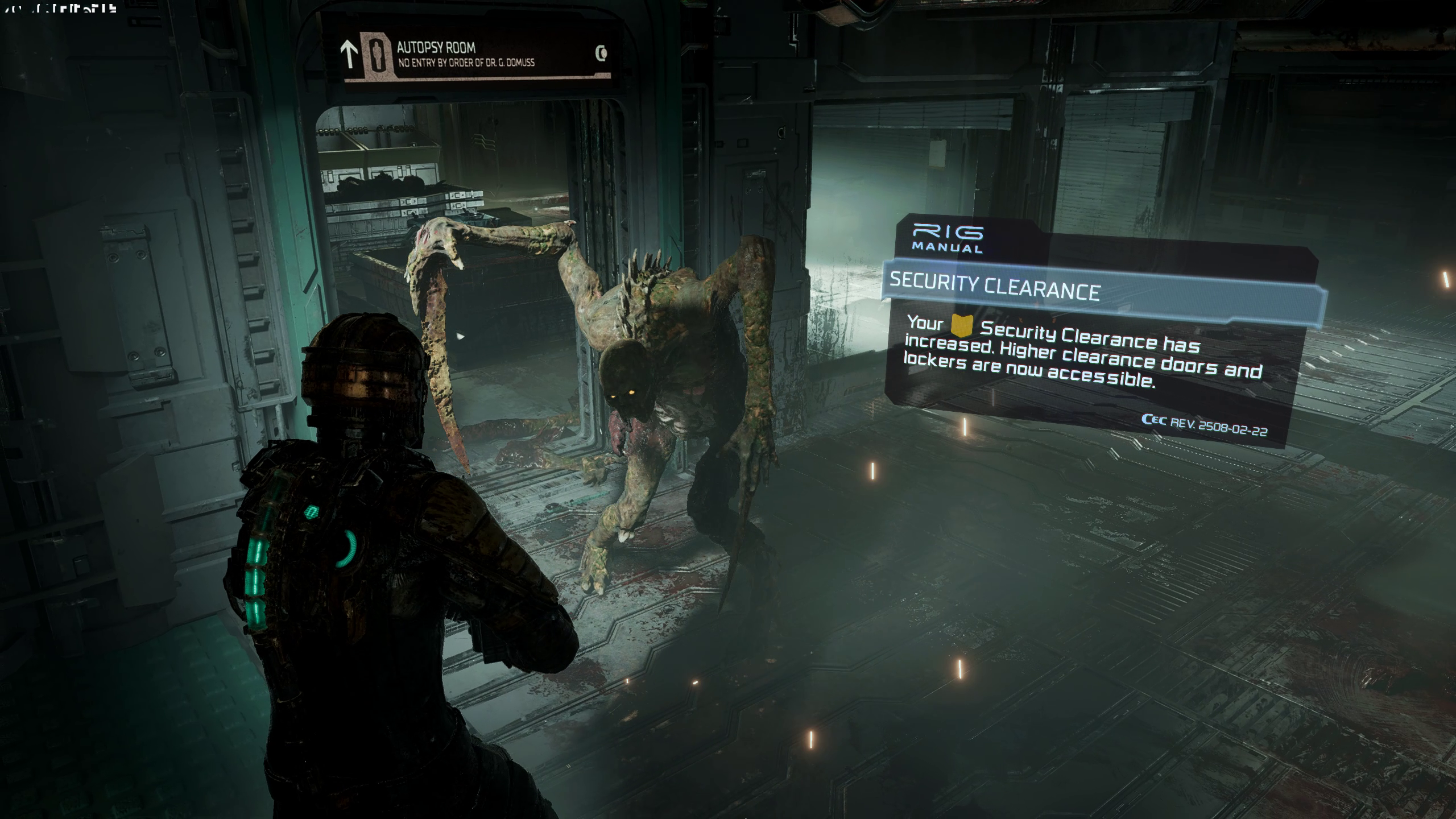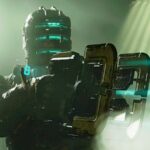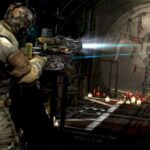
After I consider the primary Useless Area, I image unvoiced engineer Isaac Clarke creeping by means of the corridors of the mining ship Ishimura, accompanied solely by the groans of iron joints and the roars of reanimated corpses. His face is at all times obscured by the three glowing green bars on his helmet—like Sam Fisher if he had been a BioShock character—and his solely human firm comes from warnings finger-painted onto the partitions in blood.
My reminiscence is such rubbish.
I not too long ago performed the primary few chapters of the upcoming Useless Area remake at one among EA’s workplaces, and as Isaac arrived on the Ishimura, helmet off, standing among the many chatty crew of an emergency restore ship, I questioned why Motive Studio would so overtly defy the lonely temper of the unique. My first trace that I was the one who was improper got here whereas speaking to a different participant in regards to the gross eyeball scene we might each been bracing for. He realized earlier than me that the scene we had been considering of occurred in Useless Area 2, not Useless Area.
I used to be a minimum of right in remembering that Isaac does not converse within the unique Useless Area (he does right here, moderately), however the impression of solitude it left on me wasn’t correct in any respect. Isaac’s acquired a girlfriend for crying out loud, and within the unique and the remake, a pair of crewmates and others bug him with video calls all through the ordeal on the Ishimura. Even the lifeless speak to him, as a result of earlier than their corpses grew to become puppets for alien DNA, they recorded their day-to-day considerations in audio logs that they carelessly left scattered all through the ship’s amenities. I might forgotten how huge of a buzzword “environmental storytelling” was again in 2008. BioShock and Fallout 3 had been filled with audio diaries and Pompeii-style corpse poses, too.
Vertical slice
So it seems that the Useless Area remake is fairly trustworthy to the game I performed in 2008. As engineer Isaac Clarke—managed from a detailed third-person-perspective—you carve up the alien undead as you progress by means of the Ishimura fixing its busted programs. The alien carving is most memorably accomplished with the plasma cutter, a device which shoots vertical or horizontal strains that sever the fang-like limbs of the “necromorphs.” Within the late 2000s, limb-severing know-how was nonetheless fairly sizzling. A couple of years earlier, we might been attaining comparable outcomes flinging sawblades round with the Gravity Gun in Half-Life 2’s Ravenholm, a stage which was far too quick for the way enjoyable it was. Useless Area was kind of the reply to the query, “Why not make the entire game out of Ravenholm?” It neatly made the conventional weapons backup weapons, and the principle gun the cool, unconventional one which slices off limbs.
The plasma cutter is as a lot enjoyable within the remake because it was within the unique. The one huge distinction is that the rotten pores and skin of the necromorphs is now not a blurry mess of pus and blood-colored pixels. It is shiny, and it peels away to disclose pink muscle. Graphics are the one space where my false reminiscence aligns with the brand new Useless Area: It appears like how I keep in mind Useless Area wanting 14 years in the past, though the unique could not have regarded almost this advanced, gross, or realistically lit. I like that Isaac’s huge stomps—used to squish necromorph corpses, inflicting ammo or cash to come out—are nonetheless animated within the chunky, not-quite-natural means standard on the top of the Gears of Struggle period.
One thing else that had gone fuzzy in my reminiscences had been Isaac’s techo-magical powers; Useless Area had extra parallels with BioShock than I recalled. The telekinesis skill is most enjoyable to make use of for chucking spear-shaped particles on the necromorphs, pinning them to partitions just like the nailgun in FEAR. I am much less delighted by its function in moving bins, sticking huge batteries in huge battery slots, and reconnecting gears. There’s additionally a stasis skill used for sticking objects collectively and slipping by means of malfunctioning doorways. It is extra artificial-feeling than I keep in mind, with glowing magnet stickers telling you when it would be a good suggestion to attempt manipulating them. However that is the way it was within the unique, too.
What’s new
The remake seems to go away the necessary physics puzzles roughly as-is, however provides one fascinating elaboration. Some rooms include fuse bins that will let you energy up programs as long as you are keen to energy one other system down. You may flip an elevator on on the expense of turning the lights off, for instance—the concept that it’s important to make issues scarier for your self to progress is cute. I am instructed that later within the game you may should depressurize areas of the Ishimura, or flip off gravity, which might have enjoyable penalties if accomplished cleverly.
Within the zero-G sections of the unique Useless Area, you had been caught to the ship with magnet boots, and will solely leap from floor to floor. Within the remake, you possibly can fly round like you possibly can within the sequels, and it is enjoyable to trace leaping necromorphs as they zoom by means of area.
You can even discover this model of the Ishimura from front-to-back with out loading; it is all “one shot,” the builders say. And in contrast to the unique, you will not be fully protected if you return to areas you’ve got already explored. All through the remake, an “depth AI” will combine shock necromorph assaults in with the pre-scripted ones, and in any other case attempt to spook you by messing with the lights and sounds. A room that was well-lit in a single playthrough may be darkish on a second, as an illustration.
It isn’t like Left 4 Useless, where zombies emerge from doorways like bees from a hive—I by no means went, “Ah, the AI is at work right here”—so it looks like a delicate addition. The identical goes for the choice to place Isaac’s voice actor, Gunner Wright, again to work. Isaac was voiced by Wright in Useless Area 2 and three, so it isn’t just like the spirit of the collection as an entire has been violated, and Motive retains the Isaac dialogue easy. Useless Area would not profit from Isaac muttering stuff like “want some juice for my plasma cutter” as he clomped round, so I used to be relieved to seek out out that he solely speaks in response to somebody chatting with him.
Staying in character
It could’ve been straightforward for Motive to justify making Isaac ship hints by speaking to himself, since Useless Area is legendary for its dedication to maintaining the fourth wall intact. It is one of many few video games where you do not want a console command to take a HUDless screenshot, as a result of there is no such thing as a HUD. Excluding subtitles, no info in any respect is displayed with out an in-game context. Isaac’s health is indicated by glowing bars working up the backbone of his go well with, for instance, and weapons have holographic sights which show their remaining ammo.

That in-world UI remains to be cool as we speak, nevertheless it induced issues in 2008 and causes the identical ones now. It is annoying when a floating notification distracts me throughout a combat, and the mouse and keyboard controls are sort of dangerous. Since all of the menus seem on this planet as holographic projections, you do not lose management over Isaac’s physique if you open them, so WASD and the mouse aren’t freed-up for navigation. As a substitute, it’s important to discover different keys to make use of to flip between menu tabs or stock gadgets. By default, it is the arrow keys. If, like me, you possibly can’t stand that, you may should give you some bizarre keybinding scheme of your personal or simply settle for that Useless Area was designed for controllers. (Within the unique, you possibly can hold Alt to take awkward mouse management over components of the menus, which I assume works within the remake though I forgot to attempt it.)
ABOVE: Oops.
Different issues with the unique Useless Area on PC, nonetheless, do not look like replicated. I replayed a little bit of the unique after attempting the remake, and the mouse acceleration is extra horrifying than any necromorph. Additionally, the primary corpse I encountered changed into a ball of infinite power and flew across the room smacking its limbs all around the partitions. I type of miss that traditional ragdoll bug, nevertheless it’s not very eerie. The unfinished remake construct I performed had some bugs of its personal—framerate dives, a sure motion that turned me right into a noclip ghost (they instructed me to not do it, so after all I did it)—however EA mentioned these points had been accounted for, and would not make it to the ultimate launch.
If that’s the case, the brand new Useless Area might be loads just like the previous one, besides with fashionable graphics, fewer mid-2000s bugs, and a much more detailed Ishimura. There are some new puzzles and a few shock scares from the “depth AI,” however nothing that drastically alters the unique sequence of occasions. I wrestle to consider a greater technique to remake a current traditional like Useless Area, however I do marvel if $60 might be a tough promote for a rebuilt 2008 horror game (in this financial system?). The Resident Evil 2 remake appeared to be standard, although, so possibly the time is true to carry again landmarks within the survival horror style.
The Useless Area remake will launch on Steam on January 27, 2023. The unique game remains to be accessible for $20, and has had its identify modified to Useless Area (2008).









